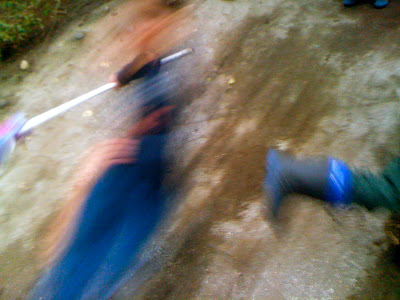I've been part of these conversations for a long time, involving a lot of different children, and it always goes down more or less the same way. Someone proposes "No weapons" and everyone agrees. Then I ask about pretend weapons. Someone says "No pretend weapons." I ask why and someone answers that even pretend weapons are scary. We agree that no one should be afraid in preschool and that's that. I honestly don't think so, but I've often wondered if this rule is made simply because the kids believe it's what the grown-ups want, that we've expressed our anti-gun sentiments (and in Seattle, in Fremont, we're mostly anti-gun people) so clearly that the kids are just reflecting it back at us.
This year, I'd expected our weapons discussion to go more or less the same way. As I'd expected, we banned weapons during our first week in class, but when I asked about pretend weapons, I was surprised by the response. "Pretend weapons are okay."
I asked, leadingly, "Aren't you worried some people will be scared of the pretend weapons?"
"We know the difference between real and pretend weapons, Teacher Tom." I probed and prodded, but if anything the group's conviction became stronger. All of them, boys and girls, agreed that pretend weapons were okay.

I'll be honest: I don't like it. At any given moment, someone in the outdoor classroom is in someone else's crosshairs. And the play is intense. It's something that's happened mostly outdoors, this weapons play. We start our days out there and I've had several parents tell me that getting their child to school on time is a piece of cake compared to previous years because they don't want to miss even a single minute of "outside time." It's the boys who seem the most excited by it, but there are girls right in the middle of the action as well, usually without guns, opting more often than not for wands. I've tried, in quiet moments to get one of the girls or less enamored boys to admit to feeling afraid of the weapons play, only to be told, quite clearly, that, "No, I am not afraid."
This has been ongoing since September and it has ebbed and flowed. At one point the focus was on swords, but after Rex took home a nasty bruise on his back, the kids agreed they ought to ban "swinging weapons," both real and pretend, so we're back to "shooting weapons," and mostly guns. Children and adults have objected at times to being "targeted," so we have agreed that you may only "shoot" at people who you know are part of the game.
In truth, when I step back and really watch what's going on, as opposed to merely reacting, I see much less shooting and much more running around with sticks of one kind or another. I hear much more discussion about "teams" (it appears the requirement for joining any one team is to simply declare yourself a member and you're in) or specific roles within the games (bad guy, good guy, guard, ninja, etc.). I watch constantly for facial expressions that tell me someone is in over his head or lost himself in the game and forgotten he can say, "Stop!" I remain vigilant for things getting out of control, for someone too excited by the game, who appears to be crossing the line between pretend and real, as what happened when Rex got his bruise.

But mostly I remember similar games I played as a boy, running wildly, hiding, imagining myself as a cowboy then an indian, a cop then a robber, a good guy then a bad guy. I knew the difference between real and pretend weapons, just as I knew that I wasn't really a cop or a robber. I remember that my mom didn't like it. She would ask, "Why do you play such violent games?" but never insisted we stop, although I recall there were some neighborhood boys who were not allowed to play with us when we played guns. I reckon that my constant asking after everyone, my vigilance, is sending the kids the same message my mom sent me.
Last week our stick ponies became the weapons. It was really getting under my skin, but what made me intervene was the way they were waving those sticks around in one another's faces. After several reminders about our rule against "swinging weapons," I intervened more firmly, saying, "I'm worried about those sticks. I keep seeing you guys poking them into each other's faces."
"But we're just shooting, Teacher Tom. They aren't swinging weapons."
"I understand, but it looks like you're swinging them in people's faces. It's my job to keep everyone safe. What you're doing doesn't look safe."
Henry looked at his stick pony weapon for a moment, then flipped it around so that the plush pony head end was forward. "How about like this?"
"That part is soft and won't hurt as much if you accidentally hit someone in the face. I like it. Does everyone agree?"
Everyone agreed and the game re-commenced.
I put a lot of time and effort into this blog. If you'd like to support me please consider a small contribution to the cause. Thank you!